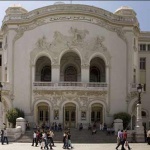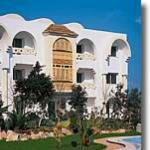Sights Tunisia, Tunisia
 In Tunisia, many architectural landmarks that reflect the history of the rich Arab culture. From the Middle Ages in the city preserved stone gate of Bab al-Menard and Bab al-Jadid, built in the XIII century.
In Tunisia, many architectural landmarks that reflect the history of the rich Arab culture. From the Middle Ages in the city preserved stone gate of Bab al-Menard and Bab al-Jadid, built in the XIII century.In the old part of town - Medina - overlooks the Great Mosque, or Mosque of Olives - the biggest and oldest mosque (VIII cent.) In the capital and the second in Tunis after kayruanskoy. According to legend, the place where now stands the mosque, once grew beautiful olive tree (hence the name).
Under the walls of the mosque archaeologists discovered the foundations of the Roman Forum. In the tanks under the courtyard of a mosque is going to rain water, which is used for ritual ablutions before prayer. Arcades and decorated ceiling carvings prayer hall is based on the marble and granite columns, taken from the buildings of Roman Carthage. Many madrassas around the mosque, reminiscent of havsidov, when Tunisia was the scientific and religious center. Here in the XIV century, he studied and taught the Tunisian Ibn educator Kaldun - "father of sociology."
Mosque of Sidi Mahreza (1675) is devoted to Abu Mohammed Mahrezu EU-Sadiq, the chief saint of Tunisia, who inspired the townspeople to restructure the city, destroyed by enemy raids 944 years. This - the only domed mosque in Medina, reminiscent of the minarets of Istanbul. Nearby is the tomb of Sidi Turbet Mahreza.
On a winding street Chateau Mosque El Kzar, built in 1106. Mosque, famous for its rectangular minaret, added to the mosque in 1674. The mosque was restored in 1979. She founded the district ruled Tunisia in XI-XII centuries. Beni Korasan who have gained power after the invasion hilaliytsev. In mosques there are in the Catholic Cathedral on Avenue Habib Bourguiba, the Jewish Synagogue on the Avenue de Paris, and already referred to a small Russian Orthodox church with gilded onion dome-onion.
All the variety and splendor of Tunisian architecture reflected in the many palaces. Some of them are now museums. The largest and best known museum of Tunisia is the Bardo Museum. Actually it is the National Museum Alawneh, Bardo Museum and its named for the palace, in which it is located. This is the largest museum of the Maghreb. There many interesting exhibits from the Stone Age to the present day. The pride of the museum - a collection of Roman mosaics - the largest in the world.
Dar Othman (XVII century), Palace of the Bey, became famous thanks to her daughter Aziza, famed for his charity work. Bay Othman was a pirate, and his daughter, Fatima Aziz, and handed the loot to the poor. The building is a fine example of Moorish architecture with a characteristic feature of the walls black and white marble. Now it houses the museum of traditional crafts.
On the outskirts of town is a green park, an array of "Belvedere", which gathered representatives of various African flora. One of the attractions of the park - giant rubber plants the length of 20-25 m. In the center of "Belvedere" is a famous alabaster arbor KUBBA - a monument of ancient Arab architecture.
